Day 2 of another three day long weekend of tours today and we made our way down to the Norfolk Broads. It was meant to rain all afternoon, but once again it was not as bad as forecast. Although we had some drizzle on and off early afternoon, it cleared up again for the end of the day.
We started with a drive along the coast. There were a few Pink-footed Geese in the fields beside the road. We drove along slowly, scanning the favoured fields, and it wasn’t long before we found our first Cranes. A pair were feeding in a field, though they were hard to see behind a bank. We pulled into a convenient layby and walked back to where we could see them. We got a good view of them through the scope, especially when they put their heads up to look round.
While the rest of the group were all looking at them, we had a scan of the grazing meadows the other side of the road. The first thing we picked up was a Short-eared Owl. It was some way over, and hard to see the other side of two reed-fringed dikes until it flew up a little at the end of each hunting run. Scanning a little further over, we found another pair of Cranes, but these were even harder to see than the first pair, from here. We got them in the scope and it was just possible to make out a grey blob through the reeds.
We were back at the car and just packing up to leave when we saw that the Short-eared Owl had come out into the open, a little nearer to us. Now we could see it properly, flying up and down the edge of one of the fields, hunting on stiff wings with a distinctive rowing action, attention focused on the ground below. As we watched it, we could see it was working its way closer and closer to the road, so we leapt into the car and drove back – just in time to have it fly along the edge of the field near the road, right beside the car. Great stuff!
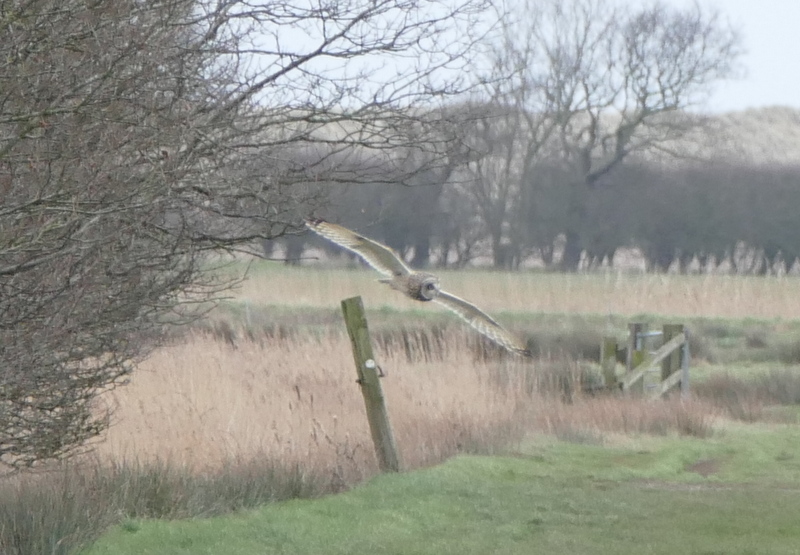 Short-eared Owl – hunting over the grazing meadows this morning
Short-eared Owl – hunting over the grazing meadows this morning
We watched the Short-eared Owl making its way round and round the field in front of us. It landed at the back briefly, down on the grass. Then flew right towards us and landed on a post. Unfortunately it didn’t stay long – and by the time the group had finished looking at it through the scope it was off. It clearly didn’t want to pose for the cameras!
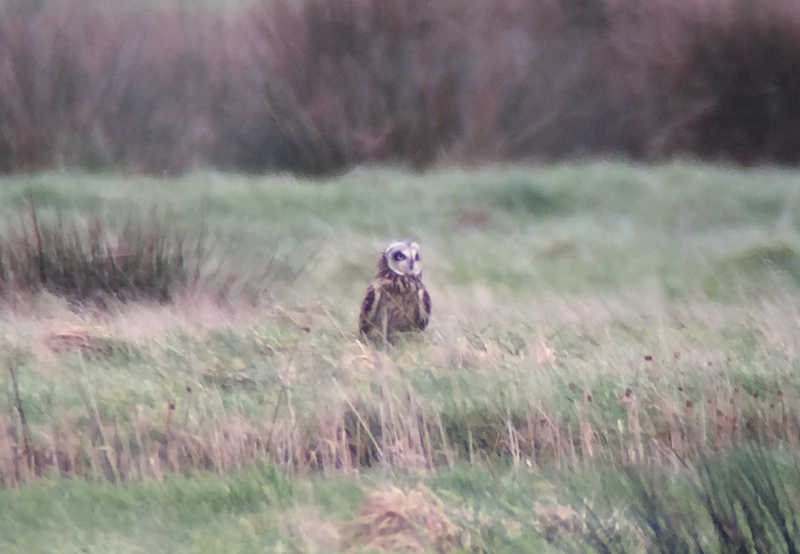 Short-eared Owl – down in the grass briefly
Short-eared Owl – down in the grass briefly
While we were distracted by the Short-eared Owl, one of the group noticed a Crane walk out of the dense rushes in the field behind. A quick scan with the scope confirmed that there were two Cranes out there. This was undoubtedly the same pair we had seen distantly earlier, but from this angle we had a much better view. For a bird which stands about a metre tall, they can be remarkably hard to see. While they were feeding in the thick rushes, they were all but invisible at times, but when they put their heads up or walked out into the more open grass, we had great views of them.
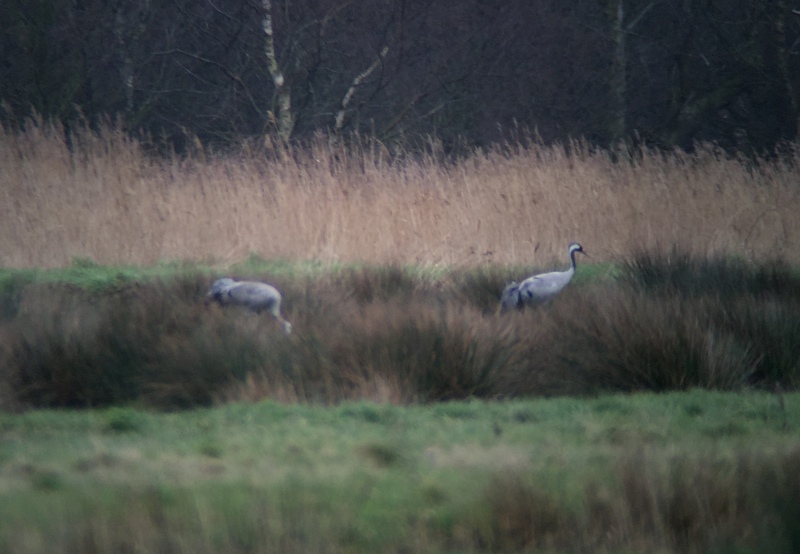 Cranes – our second pair of the day
Cranes – our second pair of the day
When we looked back to the field, suddenly there were two Short-eared Owls out hunting. A couple of times they passed through the same field of view, but most of the time they kept apart, patrolling slowly round different parts of the field at different times, although often covering the same ground one after the other. It was quite a sight to be watching a pair of Cranes and have a Short-eared Owl fly through the foreground, or vice versa!
 Short-eared Owl – two birds were patrolling the same meadow
Short-eared Owl – two birds were patrolling the same meadow
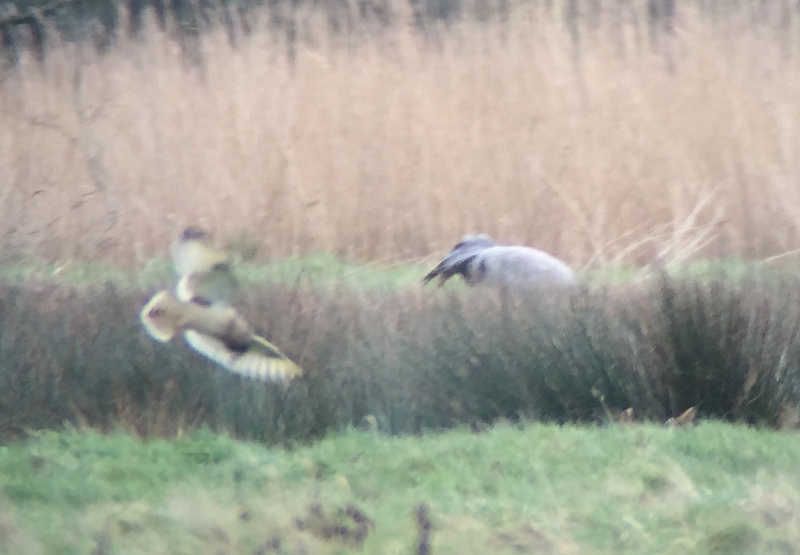 Short-eared Owl photobombing a Crane – not a sight you see everyday!
Short-eared Owl photobombing a Crane – not a sight you see everyday!
It was a magical moment, watching the Cranes and Short-eared Owls. Eventually, we had to drag ourselves away and continue on. Further back along the road, we stopped again to look at a large flock of Pink-footed Geese. We had just got out of the car and a quick scan over the grass produced yet another two more Cranes.
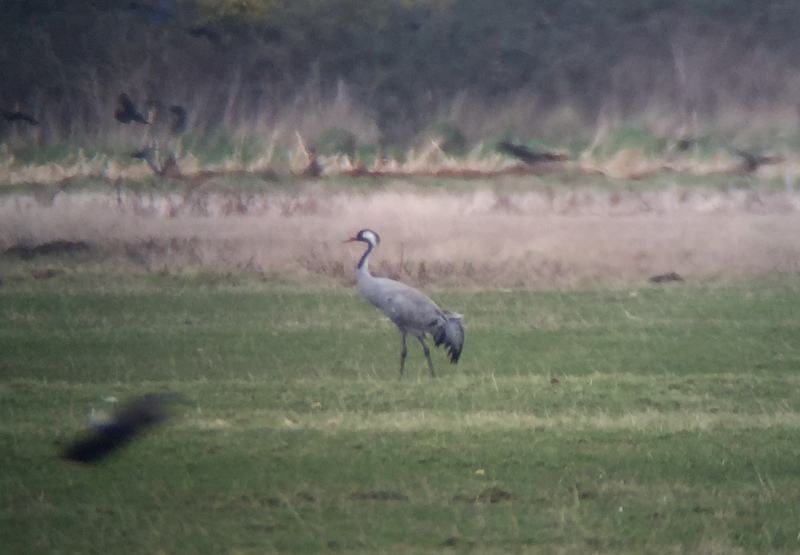 Crane – one of our third pair of the day
Crane – one of our third pair of the day
They were feeding quietly out on the grass, walking about slowly and rooting around in the ground or picking at the surface, possibly looking for worms on the short turf. When the Cranes we had been watching earlier, back along the road, started calling, this pair responded, throwing their heads back, pointing skyward, and bugling in unison. Great to watch.
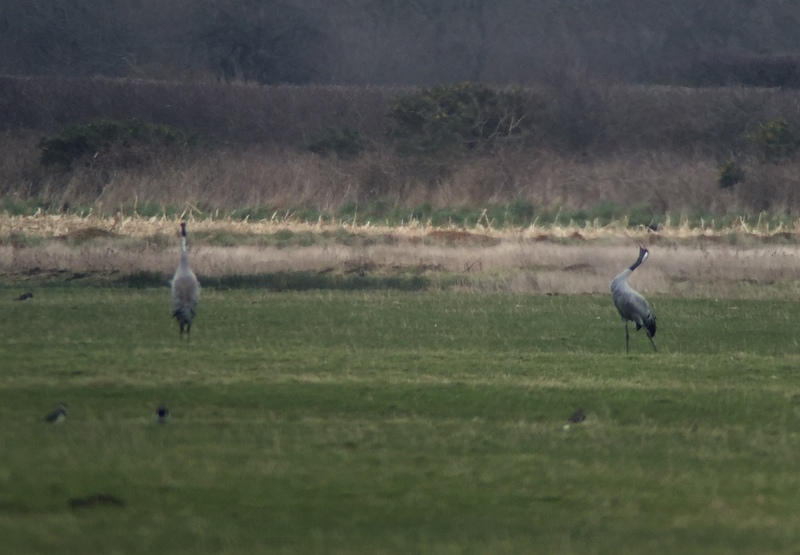 Cranes – calling in unison in response to the other pair
Cranes – calling in unison in response to the other pair
There were plenty of other birds here too. Lots of Lapwings out on the grass, all flying up whenever something spooked them. A huge flock of Golden Plover whirling round in the distance and a smaller number in the wet fields behind us. In with them, we also found a single Ruff and a couple of Dunlin. Several Marsh Harriers were quartering over the reeds.
Our next stop was down at Winterton. It being the Saturday of half term week, the beach was perhaps not surprisingly very busy – lots of people and even more dogs running about wildly. We walked north, hoping to get away from the worst of the commotion, stopping on our way to scan sea. There were loads of black Cormorants flying past or fishing out on the sea, and in amongst them flashes of white, a few Gannets circling offshore too. Scanning the sea with the scope, as well as the Cormorants, we found four smaller black shapes riding the waves, four Common Scoter diving offshore. There were good numbers of Red-throated Divers on the sea too, still in winter plumage with grey backs and bright white faces and underparts. We also picked up a single Guillemot on the sea briefly.
We hadn’t gone very far, when we spotted a couple of Snow Buntings dropping down into the dunes. We walked over and could see three Snow Buntings in a little clear area of sand and stones among the marram grass, but between us and them were also two Ringed Plover roosting. We decided to work our way round behind the dunes so as not to disturb them, but when we got round there was only one Snow Bunting left. Still, we had a good look at it in the scope, before it was flushed by a dog rampaging through the dunes and it flew away north calling.
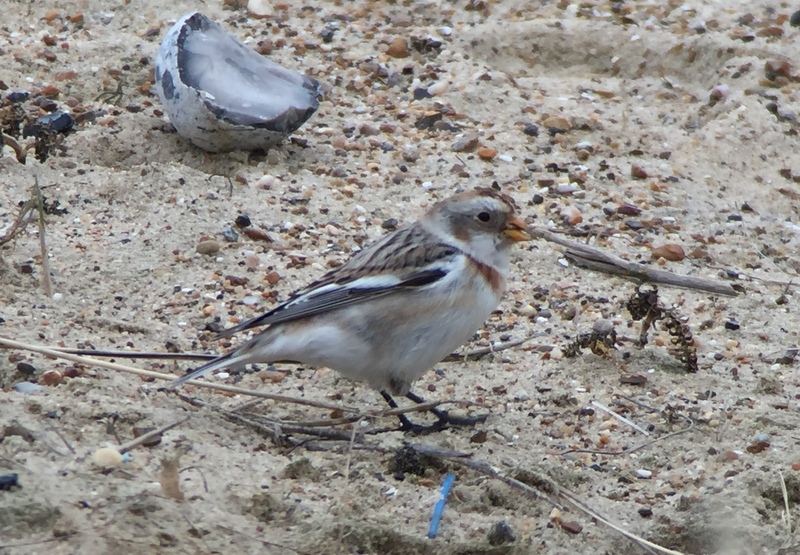
 Snow Bunting – getting flushed repeatedly by dogs on the beach today
Snow Bunting – getting flushed repeatedly by dogs on the beach today
We walked on further up through dunes and eventually found more Snow Buntings on the beach, a nice group of about ten of them picking around on the shingle. They were not getting much peace here either, constantly getting flushed by walkers and dogs, whirling around in a flutter of white wing flashes, before landing again somewhere different. The waders were not having an easy time of it either. Four Sanderling were picking around high up the beach, on the edge of the dunes, trying to make their way down to the shore before getting flushed again. In the end, we left them to it and headed back to the car.
We meandered our way inland from here, scanning various favoured sites for more Cranes. At one particular pale we picked up three more Cranes but they were very distant, out on the grazing marshes. While we were trying to get everyone onto them, yet another two Cranes flew in over the field in front of car and dropped down away to join them.
 Cranes – two flying in to join another three on the grazing marshes
Cranes – two flying in to join another three on the grazing marshes
Our next port of call was Strumpshaw Fen. A large flock of Siskins flew in noisily and began feeding in the alders around the car park. They were very jumpy and before long they were off again in a flurry away through the trees. A Goldcrest was feeding in the cut branches piled by the edge, and a Treecreeper was calling away in the wet woodland beyond.
After lunch, we walked out onto the reserve. A couple of Marsh Tits were hiding in the bushes around the feeders, calling noisily and showing themselves occasionally. The Reception Hide pool was busy with wildfowl. There were lots of Gadwall in particular, and we got a stunning male at the front in the scope. A much underrated duck, being shades of monochrome rather than gaudy colours, they are actually stunningly patterned when seen close up. Several more members of the Gadwall Appreciation Society were duly signed up!
 Gadwall – a stunningly patterned drake when seen up close
Gadwall – a stunningly patterned drake when seen up close
There were also a good number of Pochard on here today, mostly drakes and mostly asleep, plus three Teal roosting half hidden in the cut reeds at the front, and a single pair of Shoveler. A Mute Swan swam out from behind the reeds accompanied by a Black Swan, the resident escapee. Several Marsh Harriers were quartering the reeds beyond, with a male and female engaged in a bout of talon-grappling.
As we walked out through the trees, a Song Thrush was in full song. We could hear both Nuthatch and Treecreeper calling, from the woods and a Great Spotted Woodpecker landed in the trees in front of us. Another smaller flock of Siskins were in the wet alders by the start of Sandy Wall.
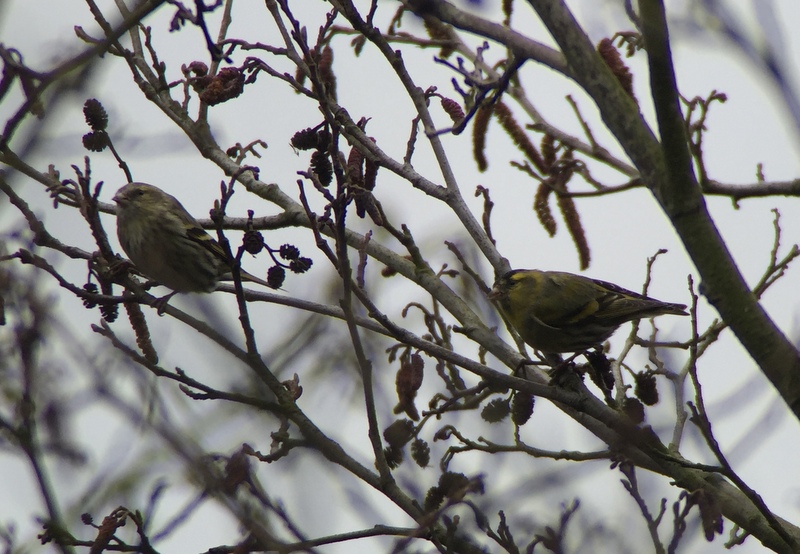 Siskins – lots were feeding in the alders today
Siskins – lots were feeding in the alders today
The view from Fen Hide was quiet again. A couple of Coot were on the pool as usual and a pair of Shoveler dropped in briefly. We scanned the cut reeds carefully and found a Snipe asleep, extremely well camouflaged in among the dead reed stems.The more we scanned, the more we found – a second nearby, then another two further over. One woke up and walked back into cover, disappearing from sight completely – we wondered how many more might be out there lurking unseen. A Cetti’s Warbler called from the reeds. But there was no sign of the hoped for Bittern or Otter today.
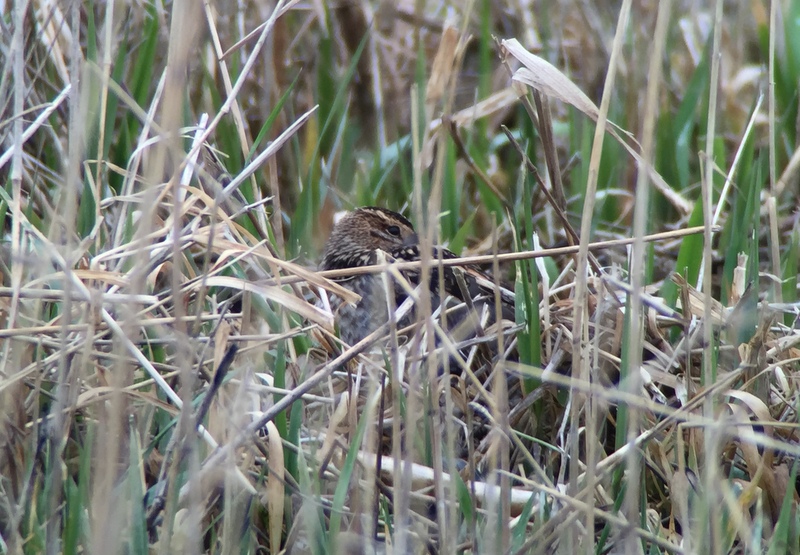 Snipe – fantastically well camouflaged, asleep among the dead reed stems
Snipe – fantastically well camouflaged, asleep among the dead reed stems
We made our way back. A Kingfisher flashed away along the ditch beside the Sandy Wall, but did not linger long enough for rest of group to get onto it. A Water Rail squealed from deep in the reedbed.
The swans at Ludham which we have been enjoying through the winter seem to have departed already, an earlier than normal return towards their breeding sites. We decided to have a quick look at an alternative location to see if we could find any birds lingering there. As we drove along, there were lots of swans in the fields, but every herd we stopped to scan through seemed to be just Mute Swans. We were about to give up when we spotted two smaller birds with shorter necks in with some distant Mute Swans. We stopped the car in a convenient field entrance for a closer scan and found at least twenty Bewick’s Swans in with them. It was a bit misty with drizzle at this point, but at least these ones had decided to stay here a little longer so we could catch up with them!
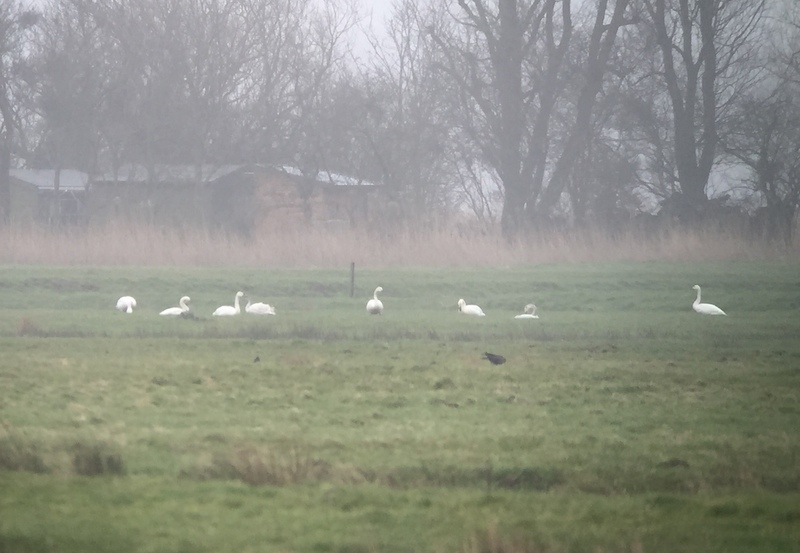 Bewick’s Swans – we eventually located 20+ in with some Mute Swans
Bewick’s Swans – we eventually located 20+ in with some Mute Swans
We finished the day at Stubb Mill. By the time we got to the car park at Hickling, the drizzle had stopped and it had even brightened up a fraction. On the walk out, we could hear the flock of Teal calling from the flood out on the grazing marshes and a large flock of Fieldfare flew over the fields. A single Redwing flew past as well.
There were not many Marsh Harriers present at first, only three or four out in the bushes, but through the late afternoon they slowly started to drift in. Then a ringtail Hen Harrier circled in high over the marshes in front of us, dropping away towards the reeds at the back. A little later we spotted another ringtail Hen Harrier coming in low from the back – though it could conceivably have been the same one coming back in after a fly round.
There are often Merlins here, but they can appear rather late to perch in the trees, or just zip through quickly. We got lucky today. First, one was perched up in the top of a rather distant bush. Then what we possibly a second darted round through the bushes in the front of the reeds and perched up nicely where we could get a great look at it through the scope. As the light started to fade, more Marsh Harriers arrived so that there were probably around twenty in tonight.
A distant Barn Owl was hunting right out the back of the reeds, despite the weather, and an early Tawny Owl hooted from behind us. A small number of Pink-footed Geese appeared to be feeding on the grazing marshes away to our left, flying up occasionally between the fields, but as dusk fell a much larger flock came up from that direction and flew off to roost. A Stonechat perched up on the brambles and a couple of Yellowhammer flew over calling. The usual Chinese Water Deer appeared out on the grass and a Stoat ran through the rushes in front of us, returning a few seconds later back the other way with something in its jaws.
One of the group was struggling with walking, so your correspondent went back to get the car. On the way back, three Cranes dropped silently over the road towards. Thankfully the rest of the group had not missed out, and had themselves seen nine more Cranes fly past the watchpoint, heading off to roost as the light faded.
What a great way to finish. That took us to a massive combined total of 23 Cranes for the day! A classic day in the Broads.
















